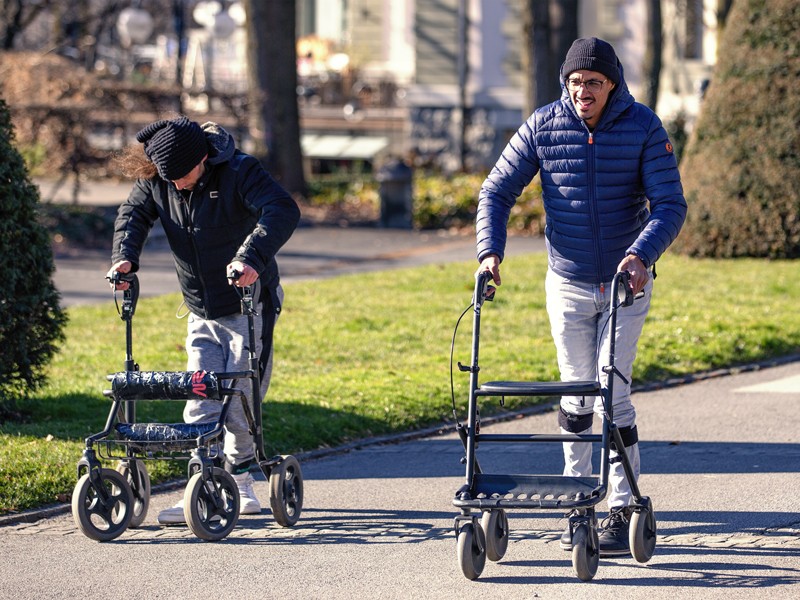Can You Walk Again After a Spinal Cord Injury
- NEWS
Stimulating spinal string helps paralysed people to walk once again
Three people once paralysed by complete spinal-cord injuries can walk, swim, work the pedals of a wheel and even paddle canoes, thanks to an implant that stimulates neurons in their spinal cords.
In a paper published on 7 February in Nature Medicine 1, neuroscientist Grégoire Courtine at the Swiss Federal Institute of Technology in Lausanne (EPFL) and his colleagues describe the first implant specifically designed to control movement past mimicking the signals the lower body ordinarily receives from the brain and upper spinal cord.
A completely severed spinal string disrupts the electrical signals from the brain that tell parts of the torso below the injury how to balance and move, resulting in paralysis that is usually irreversible. But the chain of motor neurons below the suspension frequently remains intact. Several research groups have been able to restore some move in people with spinal-cord injuries by repurposing devices designed to block chronic pain by applying an electrical electric current to neurons.
Courtine'due south group used magnetic resonance imaging and computed tomography to map the size and layout of the neurons in the spinal cords of 27 people, and created a predictive model of the average spinal cord. This helped to show a surgeon where on the recipients' bodies to place the implant's electrodes. The researchers so fine-tuned the electrical current to each individual. A team including EPFL neurosurgeon Jocelyne Bloch implanted the device into three people whose spinal cords had been completely severed, causing paralysis in the lower body.
Once the implant was in identify, each person could command the pattern of electrical stimulation, using buttons and a tablet to raise or lower each leg, for example. All three participants recovered some level of move within one day of activating the implant, including being able to walk on a treadmill while their weight was supported. "The first few steps were incredible — a dream come true!" said one of the people to receive the treatment, Michel Roccati, in a press release. The participants were also able to take role in activities such every bit pedalling a wheel and performing squats, and to keep their bodies stable while paddling canoes, using the device to guide their muscles through preprogrammed movements.
Integrated approach
Reggie Edgerton, an practise physiologist at the University of California, Los Angeles, who is working on electrical stimulation for people with spinal-cord injuries, is impressed with the level of item in the newspaper and says the approach does a good chore of integrating the "micro" elements of directed, timed activation of item neurons with the "macro" scale of ensuring that the whole body is in melody with the movement. "You don't walk but with your legs," he says.
Edgerton'due south ain method uses electrodes practical to the pare to activate spinal neurons externally, which he says might provide a less invasive solution — or at least be a stopgap until an injured person can exist implanted with a permanent device. The next question, he says, is whether stimulation over a long fourth dimension volition help the motor neurons to grow the correct connections to comport out the movement without the stimulation.
"It's really exciting," says Megan Gill, a concrete therapist at Mayo Clinic in Rochester, Minnesota, who as well works on electrical-stimulation devices for spinal-cord injury. Gill points out that the people in the written report were not fully "walking" inside ane day of treatment — much of their weight was still supported — but she is impressed by the stimulation's effectiveness.
Neurosurgeon Peter Grahn, likewise at Mayo Clinic, adds that the device's power to stimulate various neurons strategically, rather than continuously as previous devices have done, volition aid researchers to understand the dynamics of spinal-cord signalling. This could aid future efforts to restore movement to people who have also lost upper-trunk move — a much more circuitous process.
Courtine says that his group hopes to simplify the technology and then that a user can command information technology through a smartphone. The squad has received approval from the Us Food and Drug Administration to test the arrangement in a Usa-based clinical trial with more people. Courtine says the researchers program to focus on people with recent injuries, because tests in rodents have shown that animals tend to recover more movement when the stimulation begins immediately after their injury. They are as well testing a brain implant that would straight route mental instructions to the spinal-string-stimulation machinery. This device might restore other functions frequently lost because of a spinal-cord injury, such as bladder control and sexual part.
The work will give many people with spinal-cord injuries "reason to have a lot of promise", Edgerton says.
References
Source: https://www.nature.com/articles/d41586-022-00367-1

0 Response to "Can You Walk Again After a Spinal Cord Injury"
Post a Comment